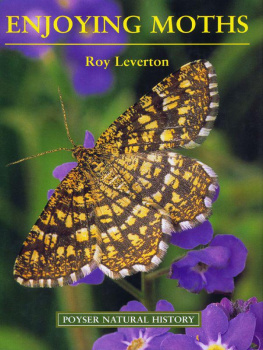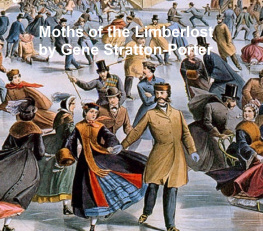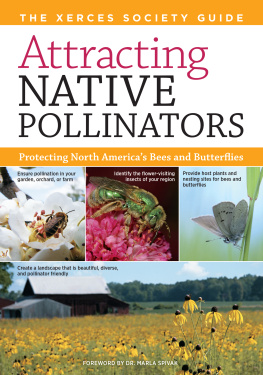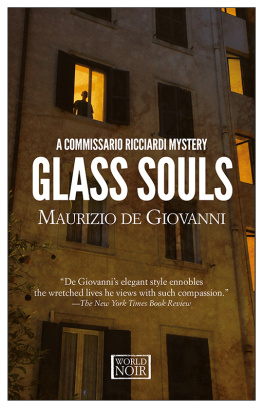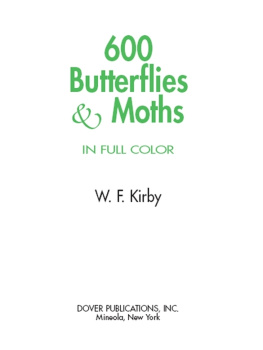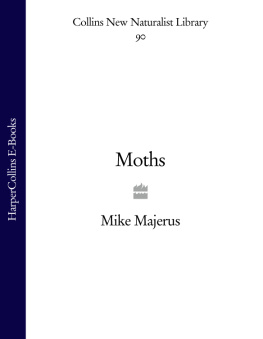Leverton - Enjoying Moths
Here you can read online Leverton - Enjoying Moths full text of the book (entire story) in english for free. Download pdf and epub, get meaning, cover and reviews about this ebook. City: London, year: 2001;2010, publisher: A&C Black Non-Trade;T & A D Poyser, genre: Children. Description of the work, (preface) as well as reviews are available. Best literature library LitArk.com created for fans of good reading and offers a wide selection of genres:
Romance novel
Science fiction
Adventure
Detective
Science
History
Home and family
Prose
Art
Politics
Computer
Non-fiction
Religion
Business
Children
Humor
Choose a favorite category and find really read worthwhile books. Enjoy immersion in the world of imagination, feel the emotions of the characters or learn something new for yourself, make an fascinating discovery.
Enjoying Moths: summary, description and annotation
We offer to read an annotation, description, summary or preface (depends on what the author of the book "Enjoying Moths" wrote himself). If you haven't found the necessary information about the book — write in the comments, we will try to find it.
Enjoying Moths — read online for free the complete book (whole text) full work
Below is the text of the book, divided by pages. System saving the place of the last page read, allows you to conveniently read the book "Enjoying Moths" online for free, without having to search again every time where you left off. Put a bookmark, and you can go to the page where you finished reading at any time.
Font size:
Interval:
Bookmark:
ROY LEVERTON was born and brought up in Salford, Lancashire. In spite of these unpromising surroundings he was interested in natural history from an early age, and particularly in moths. To further his obsession he moved to Brighton to study at the University of Sussex, and gained a Geography degree in 1967. After remaining in the overcrowded south until 1989, he then relocated with his family to Scotland, and now lives on a 35 acre croft with his wife Laurie, sons David and James, two horses and assorted livestock. He actively manages half his land for its wildlife, including 8 species of orchids, breeding Grasshopper Warblers and an ever increasing list of moths.
Always an enthusiastic amateur, Roy has been an active member of various conservation organisations both in Sussex and Scotland. He held a ringing permit for 25 years, specialising in migrant thrushes including Ring Ouzels, and spent 12 years as a voluntary warden for English Nature on a chalk downland reserve on the outskirts of Brighton. He is presently Lepidoptera recorder for Banffshire.
After collecting moths as a boy, Roy later took up photography as a kinder alternative. He provided the photographs for The Natural History of Moths by Mark Young. Although he has published many articles in scientific journals over the years, this is his first book.
Cover photograph:
Latticed Heath Chiasmia clathrata .
(Roy Leverton)
ENJOYING MOTHS
Roy Leverton
With line illustrations by
Michael Roberts

This book is printed on acid-free paper
Text Academic Press, 2001
Photographs Roy Leverton
Line art Michael Roberts
All rights reserved. No part of this book may be reproduced,
stored in a retrieval system, or transmitted in any form or
by any means, electronic, mechanical, photocopying or
otherwise, without the permission of the publisher
First published in 2001
by T & A D Poyser Ltd
32 Jamestown Road, London NW1 7BY
http://www.academicpress.com
ISBN 0-85661-124-7
eISBN : 978-1-4081-2865-7
Library of Congress Catalog Number: 00-107416
A catalogue record for this book is available from
the British Library
Designed and typeset by Peter Champion
Printed and bound by Grafos SA Arte Solore Papel,
Barcelona, Spain
01 02 03 04 05 06 GF 9 8 7 6 5 4 3 2 1
Contents
.
.
.
.
.
.
.
.
.
.
.
Appendix 1
Species totals of Macro-moths, and Micros if known, for the Watsonian Vice-Counties of Great Britain.
Appendix 2
Presumed Gains and Losses of Resident British Microlepidoptera since records began.
Appendix 3
Lepidoptera Resident in Britain believed to have been Introduced to North America.
Appendix 4
British macro-moths that are frequently active in daylight.
Appendix 5
Scientific names of species other than Lepidoptera mentioned in the text
This book is aimed at those who might wish to learn more about moths. Perhaps they consider themselves to be good general naturalists; maybe they already specialise in a different field. That would be the normal pattern. Few people consciously set out to make moths their main hobby: an interest in this group more often develops indirectly, through casual encounters while pursuing other branches of natural history.
For the ornithologist, the caterpillars of moths come to notice as a major prey of insectivorous birds, so important for nestlings that tits synchronise their breeding season to coincide with this flush of food in spring. Adult moths form part of the diet of exciting birds such as the Nightjar and Hobby. The twitcher, ever hoping for rare vagrants, knows that moths migrate too, using the same weather systems. Accordingly, most bird observatories also run a moth trap.
For those interested in mammals, the link between bats and moths is obvious, but hedgehogs, shrews, mice and voles also eat them, especially during the pupal stage. So do humans in some parts of the world, but fortunately not in Britain. Australian Aborigines harvest aestivating Bogong Moths Agrotis infusa . Native American tribes considered White-lined Sphinx Hyles lineata caterpillars a delicacy, and used them as the basis for ceremonial stews (Watson and Whalley, 1975).
For the botanist and the gardener, moth caterpillars are the most obvious cause of leaf damage. Plants have evolved many defences, both chemical and physical, against these depredations, while at the same time encouraging moths to act as pollinators. In response, moths have found cunning ways to overcome these defences, or turn them to their own advantage.
However, the most common route towards an interest in moths is via butterflies, their more showy daytime cousins. As Young (1997) rightly stresses, a butterfly is just a moth by another name. And Britain has relatively few butterflies: with moderate luck and a bit of effort it might take only a couple of years to see all the species found in a county, and not much longer to tick every resident butterfly in Britain. What then? Moths, in contrast, offer endless scope. With roughly 30 species for each butterfly, who could expect to see them all? Even after a lifetimes study, it is realistic to hope for new moths every year, perhaps without travelling further than ones own garden.
Nor should those who live in urban areas despair moths are found everywhere. My own childhood was spent in Salford, part of the Manchester conurbation. Air pollution from heavy industry was rife, and the countryside far out of reach. There was so little wildlife that I envied my schoolmates whose terraced houses had rats, and asked whether I might be permitted to come and study them. This was the Salford of Lowry. Once, the artist himself treated our school to a well-rehearsed version of his life story while trusted pupils fed him prearranged questions. What we would really have liked to ask him was why he painted Salford anyway. Art to us meant landscapes, galleons, nymphs surprised while bathing, and great cities like Paris, Rome and Venice, not industrialised slums.
Yet even in that desperate environment there were moths, with the added interest that so many had evolved dark (melanic) forms to match their soot-polluted background. Thus began a lifelong passion that has never faded. Why should it, when moths are so fascinating? And long-awaited species can turn up almost anywhere, when least expected. Perhaps the most memorable of my own first sightings was the Privet Hawk Sphinx ligustri seen from a moving bus, bringing my journey to an unscheduled halt. What a magnificent moth! Unfortunately, it was only my third day in a new job not a good time to arrive half an hour late. In those days there was little protection: firms could, and did, sack employees on whim. The foreman listened impassively to my stammered explanation; it sounded a bit lame even to me. The silence that followed seemed unending. Finally he delivered his verdict. You got off the bus because you saw a moth ? Thats the daftest excuse Ive ever heard it must be genuine! Make up the lost time in your lunch hour.
Moths generate many such memories. As a subject for study they are inexhaustible. They lead the keen observer from the seashore to the tops of the highest mountains, through marsh and forest, across heath and moor: all environments have their characteristic species. And so does suburbia. Because moths are active at night, they make a good hobby for those forced to spend the day at school or work. What better way to unwind after a hectic spell in the office than wandering round the garden at dusk, drinking in the scent of the flowers, and watching moths as they wake to fly and feed? What other branches of natural history can be pursued even while one sleeps by running a light trap?
Next pageFont size:
Interval:
Bookmark:
Similar books «Enjoying Moths»
Look at similar books to Enjoying Moths. We have selected literature similar in name and meaning in the hope of providing readers with more options to find new, interesting, not yet read works.
Discussion, reviews of the book Enjoying Moths and just readers' own opinions. Leave your comments, write what you think about the work, its meaning or the main characters. Specify what exactly you liked and what you didn't like, and why you think so.

